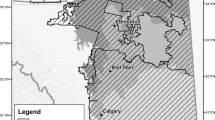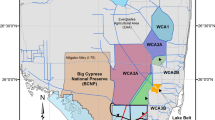Abstract
Context
Strong reciprocal interactions exist between landscape patterns and ecological processes. In wetlands, hydrology is the dominant abiotic driver of ecological processes and both controls, and is controlled, by vegetation presence and patterning. We focus on binary patterning in the Everglades ridge-slough landscape, where longitudinally connected flow, principally in sloughs, is integral to landscape function. Patterning controls discharge competence in this low-gradient peatland, with important feedbacks on hydroperiod and thus peat accretion and patch transitions.
Objectives
To quantitatively predict pattern effects on hydrologic connectivity and thus hydroperiod.
Methods
We evaluated three pattern metrics that vary in their hydrologic specificity. (1) Landscape discharge competence considers elongation and patch-type density that capture geostatistical landscape features. (2) Directional connectivity index (DCI) extracts both flow path and direction based on graph theory. (3) Least flow cost (LFC) is based on a global spatial distance algorithm strongly analogous to landscape water routing, where ridges have higher flow cost than sloughs because of their elevation and vegetation structure. Metrics were evaluated in comparison to hydroperiod estimated using a numerically intensive hydrologic model for synthetic landscapes. Fitted relationships between metrics and hydroperiod for synthetic landscapes were extrapolated to contemporary and historical maps to explore hydroperiod trends in space and time.
Results
Both LFC and DCI were excellent predictors of hydroperiod and useful for diagnosing how the modern landscape has reorganized in response to modified hydrology.
Conclusions
Metric simplicity and performance indicates potential to provide hydrologically explicit, computationally simple, and spatially independent predictions of landscape hydrology, and thus effectively measure of restoration performance.









Similar content being viewed by others
References
Aich S, McVoy CW, Dreschel TW, Santamaria F (2013) Estimating soil subsidence and carbon loss in the Everglades Agricultural Area, Florida using geospatial techniques. Agric Ecosyst Environ 171:124–133
Bullock A, Acreman M (1999) The role of wetlands in the hydrological cycle. Hydrol Earth Syst Sci 7(3):358–389
Burnham KP, Anderson DR (2002) Model selection and multimodel inference: a practical information-theoretic approach. Springer, New York
Cheng Y, Stieglitz M, Turk G, Engel V (2011) Effects of anisotropy on pattern formation in wetland ecosystems. Geophys Res Lett 38(4):L04402
Cohen M, Watts D, Heffernan J, Osborne T (2011) Reciprocal biotic control on hydrology, nutrient gradients, and landform in the greater Everglades. Crit Rev Environ Sci Technol 41:395–429
Corry RC, Nassauer JI (2005) Limitations of using landscape pattern indices to evaluate the ecological consequences of alternative plans and designs. Landsc Urban Plan 72(4):265–280
D’Odorico P, Engel V, Carr JA, Oberbauer SF, Ross MS, Sah JP (2011) Tree-grass coexistence in the everglades freshwater system. Ecosystems 14(2):298–310
Deutsch CV, Journel AG (1998) GSLib. Geostatistical software library and user’s guide
D’Odorico P, Laio F, Porporato A, Ridolfi L, Rinaldo A, Rodriguez-Iturbe I (2010) Ecohydrology of terrestrial ecosystems. Bioscience 60(11):898–907
Doren RF, Trexler JC, Gottlieb AD, Harwell MC (2009) Ecological indicators for system-wide assessment of the greater everglades ecosystem restoration program. Ecol Ind 9(6):S2–S16
Eastman JR (1989) Pushbroom algorithms for calculating distances in raster grids. In: Proceedinds of Autocarto, vol. 9, pp 288–297
Eastman JR (1990) IDRISI: a grid-based geographic analysis system. Clark University, Graduate School of Geography
Egler FE (1952) Southeast saline Everglades vegetation, Florida and its management. Vegetatio 3(4–5):213–265
Eppinga MB, Rietkerk M, Borren W, Lapshina ED, Bleuten W, Wassen MJ (2008) Regular surface patterning of peatlands: confronting theory with field data. Ecosystems 11(4):520–536
Eppinga MB, de Ruiter PC, Wassen MJ, Rietkerk M (2009) Nutrients and hydrology indicate the driving mechanisms of peatland surface patterning. Am Nat 173(6):803–818
Givnish TJ, Volin JC, Owen VD, Volin VC, Muss JD, Glaser PH (2008) Vegetation differentiation in the patterned landscape of the central Everglades: importance of local and landscape drivers. Glob Ecol Biogeogr 17(3):384–402
Gustafson EJ (1998) Quantifying landscape spatial pattern: what is the state of the art? Ecosystems 1(2):143–156
Hagerthey SE, Newman S, Rutchey K, Smith EP, Godin J (2008) Multiple regime shifts in a subtropical peatland: community-specific thresholds to eutrophication. Ecol Monogr 78(4):547–565
Harvey J, Schaffranek R, Noe G, Larsen L, Nowacki D, O’Connor B (2009) Hydroecological factors governing surface water flow on a low-gradient floodplain. Water Resour Res 45(3)
Heffernan JB, Watts DL, Cohen MJ (2013) Discharge competence and pattern formation in peatlands: a meta-ecosystem model of the Everglades ridge-slough landscape. Plos One 8(5):e64174
Kaplan DA, Paudel R, Cohen MJ, Jawitz JW (2012) Orientation matters: patch anisotropy controls discharge competence and hydroperiod in a patterned peatland. Geophys Res Lett 39(17)
Kupfer JA (2012) Landscape ecology and biogeography: rethinking landscape metrics in a post-FRAGSTATS landscape. Progr Phys Geogr. ISSN 0309133312439594
Lago ME, Miralles-Wilhelm F, Mahmoudi M, Engel V (2010) Numerical modeling of the effects of water flow, sediment transport and vegetation growth on the spatiotemporal patterning of the ridge and slough landscape of the Everglades wetland. Adv Water Resour 33(10):1268–1278
Larsen L, Harvey J, Crimaldi J (2007) A delicate balance: ecohydrological feedbacks governing landscape morphology in a lotic peatland. Ecol Monogr 77(4):591–614
Larsen LG, Harvey JW (2010) How vegetation and sediment transport feedbacks drive landscape change in the Everglades and wetlands worldwide. Am Nat 176(3):E66–E79
Larsen LG, Choi J, Nungesser MK, Harvey JW (2012) Directional connectivity in hydrology and ecology. Ecol Appl 22(8):2204–2220
Light SS, Dineen JW (1994) Water control in the Everglades: a historical perspective. In: Davis SM, Ogden JC (eds) Everglades: the ecosystem and its restoration. St. Lucie Press, Delray Beach, pp 47–84
Ludwig JA, Eager RW, Bastin GN, Chewings VH, Liedloff AC (2002) A leakiness index for assessing landscape function using remote sensing. Landscape Ecol 17(2):157–171
Ludwig JA, Eager RW, Liedloff AC, Bastin GN, Chewings VH (2006) A new landscape leakiness index based on remotely sensed ground-cover data. Ecol Ind 6(2):327–336
McGarigal K, Cushman SA, Neel MC, Ene E (2002) FRAGSTATS: spatial pattern analysis program for categorical maps
McVoy CW, Park WA, Obeysekera J, VanArman J, Dreschel TW (2011) Landscapes and hydrology of the pre-drainage Everglades. University Press of Florida, Gainesville
National Research Council (NRC), Progress toward restoring the everglades: the first biennial review (2006) Committee on independent scientific review of everglades restoration progress (CISRERP). National Academies Press, Washington, DC
Nungesser M (2011) Reading the landscape: temporal and spatial changes in a patterned peatland. Wetlands Ecol Manage 19(6):475–493
O’Neill RV, Riitters KH, Wickham JD, Jones KB (1999) Landscape pattern metrics and regional assessment. Ecosyst Health 5(4):225–233
Opdam P, Foppen R, Vos C (2001) Bridging the gap between ecology and spatial planning in landscape ecology. Landscape Ecol 16(8):767–779
Reddy KR, Diaz OA, Scinto LJ, Agami M (1995) Phosphorus dynamics in selected wetlands and streams of the Lake Okeechobee Basin. Ecol Eng 5(2):183–207
Restoration Coordination and Verification (RECOVER) (2006b) Report on Evaluation Tools, Models, Work Plans, and Budgets. c/o U.S. Army Corps of Engineers Jacksonville District, Jacksonville, FL, and South Florida Water Management District, West Palm Beach
Rietkerk M, Van de Koppel J (2008) Regular pattern formation in real ecosystems. Trends Ecol Evol 23(3):169–175
Ross MS, Mitchell-Bruker S, Sah JP, Stothoff S, Ruiz PL, Reed DL, Jayachandran K, Coultas CL (2006) Interaction of hydrology and nutrient limitation in the Ridge and Slough landscape of the southern Everglades. Hydrobiologia 569:37–59
Rutchey K, Vilchek L (1999) Air photointerpretation and satellite imagery analysis techniques for mapping cattail coverage in a northern Everglades impoundment. Photogramm Eng Remote Sens 65(2):185–191
Rutchey K, Schall TN, Doren RF, Atkinson A, Ross MS, Jones DT, Madden M, Vilcheck L, Bradley KA, Snyder JR, Burch JN, Pernas T, Witsher B, Pyne M, White R, Smith III TJ, Sadle J, Smith CS, Patterson ME, Gann GD (2006) Vegetation classification for South Florida Natural Areas. US Geological Survey, Open-File Report 2006–1240, St. Petersburg, Florida, p 142
Rutchey K, Schall T, Sklar F (2008) Development of vegetation maps for assessing Everglades restoration progress. Wetlands 28(3):806–816
Schaffranek RW (2004) Simulation of surface-water integrated flow and transport in two-dimensions: SWIFT2D User’s Manual. US Department of the Interior, US Geological Survey
SCT (2003) The role of flow in the Everglades ridge and slough landscape. Science Coordinating Team, South Florida Ecosystem Restoration Working Group, Miami, FL, USA. https://sofia.usgs.gov/publications/papers/sct_flows/
Sklar FH, van der Valk A (2002) Tree islands of the Everglades. Springer, New York
Suding K, Gross K, Houseman G (2004) Alternative states and positive feedbacks in restoration ecology. Trends Ecol Evol 19(1):46–53
Tongway DJ, Ludwig JA (1997) The conservation of water and nutrients within landscapes. In: Ludwig J, Tongway D, Freudenberger D, Noble J, Hodgkinson K (eds) Landscape ecology, function and management: principles from Australia’s rangelands. CSIRO publishing, Melbourne, pp 13–22
Turner MG (1989) Landscape ecology: the effect of pattern on process. Ann Rev Ecol Syst 29:171–197
Turner MG, Gardner RH, O’Neill RV (2001) Landscape ecology in theory and practice: pattern and process. Springer, New York
Watts D, Cohen M, Heffernan J, Osborne T (2010) Hydrologic modification and the loss of self-organized patterning in the ridge-slough mosaic of the Everglades. Ecosystems 13(6):813–827
Willard DA, Bernhardt CE, Holmes CW, Landacre B, Marot M (2006) Response of Everglades tree islands to environmental change. Ecol Monogr 76(4):565–583
Wu J, Hobbs R (2002) Key issues and research priorities in landscape ecology: an idiosyncratic synthesis. Landscape Ecol 17(4):355–365
Wu Y, Wang N, Rutchey K (2006) An analysis of spatial complexity of ridge and slough patterns in the Everglades ecosystem. Ecol Complex 3(3):183–192
Yuan J (2015). Metrics of pattern loss and ecosystem change in the ridge and slough mosaic of the Everglades. Retrieved from ProQuest Dissertations and Theses (Accession Order No. AAT)
Acknowledgments
We would like to thank Likai Zhu for his assistance in Python programming and R scripting. Danielle Watts, Jim Heffernan, Joseph Delesantro, Stephen Casey and Jim Jawitz have all been invaluable resources for discussing the ideas presented in this work. We also acknowledge the constructive inputs from two anonymous reviewers whose suggestions greatly improved the paper.
Author information
Authors and Affiliations
Corresponding author
Rights and permissions
About this article
Cite this article
Yuan, J., Cohen, M.J., Kaplan, D.A. et al. Linking metrics of landscape pattern to hydrological process in a lotic wetland. Landscape Ecol 30, 1893–1912 (2015). https://doi.org/10.1007/s10980-015-0219-z
Received:
Accepted:
Published:
Issue Date:
DOI: https://doi.org/10.1007/s10980-015-0219-z




